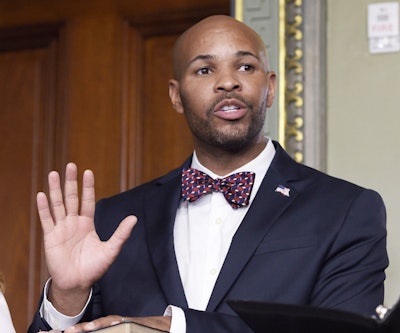Around 64,000 Americans died from drug overdoses in 2017 alone, a figure that rose more than 22 percent from the year prior. The number of deaths from synthetic opioids has seen a particularly troubling rise. In 2016, 20,000 people died from overdoses, up from 3,000 just three years before.
 Surgeon General Jerome Adams
Surgeon General Jerome AdamsExperts say combatting this public health crisis will take concerted initiatives at the federal level, through public and private partnerships, and in schools, colleges and communities across the nation. According to United States Surgeon General Jerome Adams, pastors, teachers and community leaders will have a crucial role to play.
“This problem is so multifactorial that it is going to be difficult to have a single person at the point giving directives,” Adams said at the Milken Institute’s Future of Health Summit in Washington, D.C. on Tuesday. “It’s going to take a grassroots solution.”
Adams took office in September and previously was the health commissioner of Indiana, where he oversaw the state’s response to its 2015 HIV outbreak which spread among intravenous drug users. He was one of several panelists at the Milken Institute summit discussing solutions to the nation’s addiction and opioid epidemic.
Prevention education is key to addressing the problem of addiction before it takes hold, said Tammy Wincup, chief operating officer at EverFi, an education technology company that works with K-12 schools and colleges and universities. Reaching out to young people is particularly important, since non-medical use of prescription drugs is highest among young adults aged 18 to 25, according to the National Institute on Drug Abuse (NIDA).
Public service announcements can help give traction to a particular issue, Wincup said, referencing Nancy Reagan’s well-known “Just Say No” slogan that developed out of the War on Drugs campaign of the 1980s and ’90s. “I continue to see on this topic a lot of dollars going to that top line messaging,” Wincup said. Yet PSAs tend to be more effective when coupled with educational programs aimed at helping them understand the risks involved, Wincup said.
Interventions can also be effective. Steps that some states have taken include providing better access to naloxone, a drug that treats opioid overdoses, or establishing take back centers where individuals can dispose of unused prescription drugs. Virginia now allows pharmacies to dispense naloxone to individuals, without a prescription, for instance.
The state has made progress in tackling the issue, Virginia Gov. Terry McAuliffe said, but there is still more to be done. Virginia is also working with D.C. and Maryland to address drug addiction across state lines. “There are no borders to this problem,” McAuliffe said. In Virginia, 1,100 people died in 2016 as a result of the opioid crisis.
“We’ve made a lot of progress, but we’ve got to work with our colleges, our universities, our programs in K-12,” McAuliffe said. “We’ve got to tell young people early on [about] the dangers — we wait ’til too late.”
According to NIDA director Nora Volkow, the rate at which overdose deaths is growing is unprecedented. Prescription painkillers can be life-saving and necessary in certain medical circumstances, Volkow said, so simply banning them is not a viable solution. Instead the healthcare industry must look beyond a one-size-fits all approach to managing pain.
“This is a crisis that was generated in the healthcare system, mostly from good intentions, which is to treat patients [who] have pain,” Volkow said.
Adams offered similar thoughts, saying that prescription drugs are not the only way to address pain. Different forms of therapy, such as physical, art or music therapy, are also effective. “The reality is far too many people got opioids and most of the people getting them don’t need them, but if we’re going to take away those opioids we have to replace them with something else for people who have legitimate pain,” Adams said.
Staff writer Catherine Morris can be reached at cmorris@diverseeducation.



















